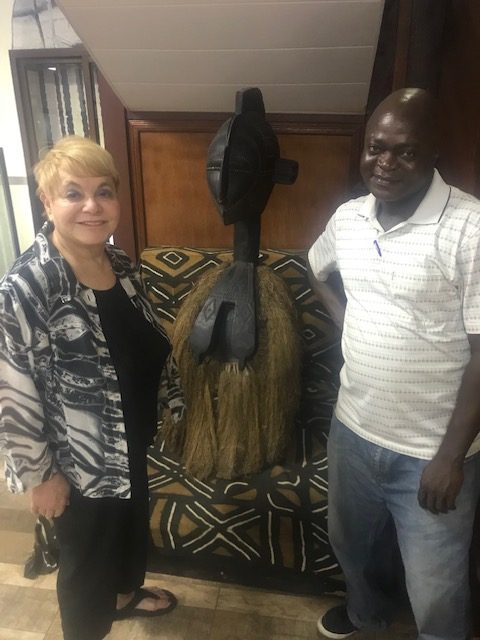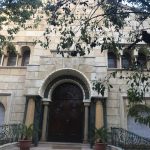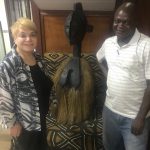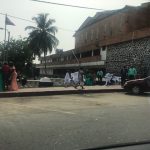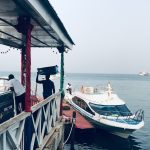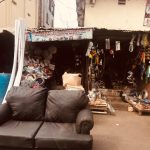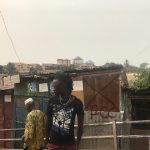Liberia and Sierra Leone (2018 – 2019)

Djibouti and Eritrea (2018)
January 1, 2018Judit, the Jewish Warrior Queen of Ancient Ethiopia
November 5, 2019Fran&Rich’s Excellent Adventures in Liberia and Sierra Leone
(With Stays at the Mamba Point and Mammy Yoko Hotels)
by Rich Juro (2018-19)
Fran signed us up for a January cruise from Capetown to Rio de Janiero, aptly named “Safari to Samba”, but she re-named it “Get Out of Omaha in the Winter”. “That’s fine,” I said, “but we need to go to some new countries on the way”. We’ve been to 40 of the 55 or so African nations, and the 15 left were pretty iffy as far as personal safety, diseases like Ebola, and other concerns. After checking the US State Department travel warning list, we found that Liberia and Sierra Leone were now rated 2 out of 4 (even we won’t go right now to places like Somalia with a rating of 3-4).
The first question was how to get there. Answer: Royal Air Maroc, the Moroccan airline, which we flew in 1966(!) from Tangier to Geneva when (listen, kids) we did Europe on $5 a Day. So we flew out of Omaha to Washington, D.C., on Christmas Day, the best and cheapest day to fly as the planes are relatively empty. After an enjoyable day with friends in DC, they drove us to get our flight to Casablanca, Morocco. Our next day’s flight to Liberia was canceled, so we toured Casablanca again.
This time, instead of the Great Mosque, we visited the Moroccan Jewish Museum and the main Casablanca Synagogue. The museum was originally erected in 1948 as a Jewish orphanage; later the building was re-done as a museum. King Mohammed VI attended the re-dedication a few years ago. It is the only museum devoted to Judaism in the Arab world. The museum has well-done artifacts and exhibits showing the thousands of years Jews have been in Morocco. Even many of the Berbers were originally Jews (the Berbers are an indigenous people who were here long before the Arabs).
Before 1948, there were approximately 300,000 Jews in Morocco, the largest concentration of Jews in the Muslim world. Most emigrated to Israel, or France, leaving about 2,500 Jews today. Its still a thriving community, but now most live in Casablanca, and there no Jews left in the Berber rural lands. There are still about 30 synagogues in the city, but we visited Beth El Temple, the biggest and most architecturally stunning. With the stained glass windows, the Bimah in the middle, and the women upstairs, its a beautiful example of a Sephardic (Mediterranean) synagogue.
Monrovia, Liberia
Liberia, located on the West African coast, has a unique history. Founded in 1822 as a settlement of the American Colonization Society, it became a new home for freed American slaves and black freemen. The migrants declared their independence in 1847, modeling the new Liberian flag and constitution on the US ones. The capital, Monrovia, was named for American President James Monroe. The settlers were called Americo-Liberians, and even though they only numbered about 5% of the Liberian populace, they controlled the government from 1847 until at least 1980.
Liberia is Africa’s first and oldest republic. It was never colonized by any European nation, the only African country to remain completely independent. After World War II, there were big investments by the USA and its corporations. Under leader William Tubman, Liberia experienced economic prosperity until his death in 1971. Unrest followed, and in 1980 Master Sergeant Samuel Doe seized control and killed the Americo-Liberian leaders. Two periods of bloody civil war resulted in 250,000 deaths (8% of the population!), and the economy fell 90%. In 1989 the notorious Charles Taylor became President, and Liberia sunk into a pariah state infamous for trading the blood diamonds of neighboring Sierra Leone.
Inspired by the Women of Liberia Mass Action Peace Movement, a peace agreement was finally signed in 2003. Ellen Johnson Sirleaf, a Harvard educated economist, became President in a free election. She recently stepped down, and the new elected leader is George Weah, an international soccer star. And the evil Charles Taylor is now in prison, convicted by the World Court for his actions in Sierra Leone.
Now, Liberia is a country of almost five million people, most of whom live in desperate poverty. The plague of Ebola struck the country in 2014, killed several thousand poor souls, and delivered a devastating health and economic blow to the nation that was just starting to recover from the rampages of two merciless civil wars. The populace hunt, eat, and export bush meat (local wild animals like monkeys, pygmy hippos, elephants, etc.). Firestone operates the largest rubber plantation in the world here. Logging, legal and illegal, is widespread. Corruption is endemic, maybe now easing slightly. Still, Liberia ranked first in the world in percentage of people saying they had bribed public officials. Basically, the economy is now dependent on foreign aid and natural resources. Norway is giving Liberia $150 million so that Liberia will not grant any more licenses to cut the forests.
We took off from Casablanca at 11 pm, which meant we arrived 2 am, in the middle of the night at an airport famed for hundreds of people “helping” you (for a large expected fee) with baggage, transportation, and other unnecessary but expensive aid. The two hour road trip to the hotel was previously dangerous with bandits and even kidnappers, but hopefully now was pretty safe. As experienced travelers, we had prepared. The big suitcases had been shipped directly from Omaha to Capetown, where we would later embark on a cruise. And when we had booked the Mamba Point Hotel, reputedly the nicest hotel in Monrovia, we had requested an airport pickup. Sure enough, after pulling our rollerboards through the crowd of “eager greeters”, we spotted a lady with Mamba Point on her uniform. She called over the driver, who led us in the dark parking lot, to a van. We gratefully clambered in, and were told to wait for another passenger.
The other passenger turned out to be Emile, the office manager of the hotel, who was just returning from vacation. Emile told us, in pretty good English: “I am the nephew of the owner of the hotel. We are a Lebanese family, and the owner’s son is the manager. Later this year I am returning to France to marry my fiance, but she doesn’t want to live in Liberia, so we will probably live in Ghana.” Ghana is more modern, and relatively more prosperous than Liberia, so it makes sense.
Emile never became chatty, but as we neared the end of the two hour trip to the hotel, he said: “By the way, as (office) manager, as I had to be picked up, I am waving the $100 fee for the pickup, and your room will be $175 per night instead of $350.” Nice hotels in West Africa are very expensive as most of the guests are businessmen and UN and NGO (non-governmental organizations) executives . I don’t know if he was upset with the owner-family, or just unhappy that he was leaving Liberia soon, but we didn’t care. That was the most rewarding airport pickup we’ve ever had, both in safe delivery and in dollars saved.
The Mamba Point Hotel was everything that people on Trip Advisor had written: quiet, fine room and bathroom, friendly and efficient service from the Lebanese-Indian-Liberian staff, good free WiFi, and delicious food from an extensive menu. Surprisingly, I even had my favorite dish, lobster thermidor, with a large lobster and a delectable sauce brimming with cheese and mushrooms. Fran had fresh local fish and baked chicken prepared as she liked it. The hotel was very safe too. Like most Liberian hotels, it had security guards, but it was also located on United Nations Avenue around the corner from the American Embassy. That meant that the Mamba Point Hotel even operated during the civil wars!
You usually cannot hire a tour company or a local guide in less developed African countries on the Internet. So we asked the hotel, and they booked us with George. Although not a real tour guide, he was friendly, a safe driver, and drove a small air-conditioned car. There’s not a lot to see in Monrovia, and its not safe to drive in the countryside except to the airport. First, we drove very slowly through a huge market: streets teeming with sidewalk vendors, shops, and thousands of pedestrians, most of whom walked right in front of the car. If another vehicle came towards us, one would have to back up through the crowd so the other could pass. Eventually, we made it through and drove to the other side of Monrovia. We caught glimpses of the river, port, beach, and small vessels. Just outside town, we saw the new President’s fine house, befitting the soccer star that he is.
Returning to town, we made it to the National Museum. It was behind a government building with dozens of people dressed up in their best clothes. The front building was where the groom and bride got their marriage licenses, and there were several handsome wedding couples and their guests waiting their turn. We respectfully walked through them and around the government offices and found the entrance to the National Museum.
Here’s what I wrote about the museum in Trip Advisor: “Old executive mansion damaged during civil war that’s now been upgraded to a fine national museum. Much of the collection disappeared during the war but is now being brought back. Ground floor has very good collection of masks, musical instruments, and other ethnographic crafts from the different tribes in Liberia. Next floor has well written history panels of Liberia from founding in early 1800’s by black American ex-slaves and freemen through the recent terrible civil wars and the Ebola epidemic. Top floor has changing exhibitions by contemporary artists; right now it has children’s paintings. Has good a/c and guides. Overall, now a surprisingly fine museum.”
Too soon (because the original Royal Air Maroc flight to Monrovia had been canceled) we had to take the long drive back to the airport. We wish the people of Liberia well, and hope that the poverty that still hinders their lives will ease.
Freetown, Sierra Leone
It was just a short flight north from Liberia to the neighboring country, Sierra Leone. But it was with a little trepidation that we walked out of the that airport too. There’s a large estuary, in fact, the largest harbor in Africa, that one has to get across to get from the airport to the capital city of Freetown. If one drives, there’s no bridge, so it would take 5-6 hours. Years ago helicopters apparently made the transit, but no more. Luckily, we happened to read about this travel glitch, and made arrangements with our hotel to have someone meet us. We were glad it was daylight and that we had shipped our big luggage directly to Capetown.
We spotted a young woman, and she directed us to a minivan, which took us for a two minute ride, where we saw a long pier heading into the water. People grabbed our two rollerboards, gave us handwritten receipts, directed us onto the wooden dock, and then helped us onto the ship. Aboard there were about 40 padded seats and life vests to wear (I was ambivalent between being happy they had life vests and worried that we’d need to use them).
After a 40 minute ride we arrived at the opposite shore. We walked on the lengthy wharf, then up the steps to the waiting/arriving room. We watched as they brought the luggage from the ship down the wooden planks and up the steps, carrying the larger suitcases on their head (it actually took less time than waiting for checked baggage in the Omaha airport). Another young woman put us into a taxi that took us to the Mammy Yoko Hotel.
Who was Mammy Yoko? She was an African lady of good lineage. She lived from 1849-1906, married three times even though she was childless, and each husband was more important than the previous one. Upon the death of her third husband, who was a chief of the Senehun tribe, she became a leader of the Mende people, and was recognized by the British colonizers as a Queen. Mammy Yoko’s name lives on in the hotel (although she was probably a better innkeeper than her namesake)!
Centuries before Mammy Yoko, in 1462, Portuguese explorer Pedro de Sintra admired the hills around this big harbor, and called it Serra Leoa, “Lion Mountain”. The area became known as Sierra Leone, or as most refer to it, as SL. Unfortunately, it also became a major slave trading port. Local chiefs sold their enemies and captives to the ship captains in exchange for European goods.
300 years later, the British realized that slavery was wrong. Beginning in 1787, a coupled of thousand settlers were sent to Sierra Leone. Most were former American slaves or black freemen who had helped or fought with the British in the American Revolution, and then were taken to Canada or London. There were a few white settlers too. Most of them, black and white, died from disease or from warfare with the local tribes. In 1799, the Brits brought 500 Jamaica Maroons to put down a revolt.
Starting in 1810, when the slave trade was condemned by England, there were thousands of Africans brought to Freetown who were “liberated” from slave ships. But they were apprenticed to whites and the Jamaica Maroons for $20 each, which was almost a form of slavery. Some progress did occur: in 1827 the first English-speaking college in Africa was established in Sierra Leone. It wasn’t until 1896 that the British annexed the inland areas as colonies. Soon after, the “Hut Tax War” between Great Britain and the local tribes broke out, but the Brits won.
After World War II, negotiations started for independence. In 1961, Sierra Leone became a new nation, complete with a place in the British Commonwealth. Sir Milton Margai was elected head of state, but he died three years later. His brother succeeded him, but instituted one-party rule, and there were several military coups. A new head of state ruled for almost 20 years, then a General, and then a brutal civil war raged from 1991-2002. During the war over 1200 primary schools were destroyed; there were thousands of child soldiers using guns and machetes; 50,000 people died; and hundreds of thousands more became refugees. Even Charles Taylor of Liberia got bloodily involved, probably for the diamonds that are locally mined. As noted above, Taylor recently went to prison for his nasty part in the SL civil war.
The economy: most of the population of almost seven million live on subsistence agriculture, with rice on the main crop. Outside of Freetown, there’s very little electricity, although there is now an attempt at developing solar power. SL is rich is natural resources: diamonds (“blood diamonds” was the term for many that were sold to finance the rebels during the civil war), titanium, gold, timber, and bauxite. The growth in the economy that the country had for the first decade of this century was given a huge setback when the Ebola virus affected several thousand in 2014-15. In this tropical climate, malaria and yellow fever are widespread, but HIV/AIDS is relatively rare. In short, over half the people still live in poverty.
The good news is that Sierra Leone has had a democratically elected government since 1998 (the rebels were defeated in 2002). The legislature is, like Nebraska’s, unicameral. Along with the 112 elected members there are 12 “paramount chiefs” who represent their districts. The President can serve two 5-year terms. Corruption is still a big problem, especially with the management of natural resources.
About 80% of the seven million people are Sunni Muslim, almost all the rest are Protestant Christian, but SL is a very tolerant nation. Officials are not elected or selected based on their religion. A friend of mine, Don Nogg, sent me an note that there was a Chabad in SL; but when I sent an inquiry e-mail, the reply was that there were perhaps two Jewish services a year and no synagogue. There is an “Israelite Congregation” called “Master of the Sabbath”, but no one but themselves consider them Jewish, and I’m not sure they really do. We hired a driver-guide, Ibrahim, through the hotel. When we asked about going to the Calaba neighborhood where the “Israelites” were, Ibrahim said: “It will take too long and I’m not sure I could find it.” So we gave up on our quest to find Jews in Sierra Leone.
There’s not much to see in and around Freetown. SL was described for travelers in Lonely Planet as the “secret beach destination” for its many miles of beautiful empty seashores, but Fran and I are not beach people. So Ibrahim drove us around the city. We stopped at the post office. They were very nice, like all SL people we met, but didn’t have the type of stamps we wanted. Then we drove toward the national museum hoping we’d find it as good as the one in Monrovia. We parked about 2 blocks away. As we rounded the corner to approach the entrance to the museum, we saw a large crowd gathered in the street. Then we heard a couple of gunshots. It was an anti-government protest. We turned around and joined the other onlookers hurrying away.
Ibrahim said, “Just wait a few minutes, and it’ll be fine.” We said, “No, let’s go,” and we did. So ended our visit to the national museum and our almost-involvement in the protest. We’re too old for this, especially in a West African country. The next day I received an e-mail from the US State Department warning Americans to avoid downtown Freetown as there were government protests. And a month later another State Department memo cautioned us about increased violent crime.
The next day we took the taxi to the boat area, gave up our two small suitcases, walked down the wharf, boarded the ship for the 40 minute ride to the opposite shore, walked the long pier to the waiting area, collected our rollerboards, and then took the van to the airport. We wish the nice people of Sierra Leone well, but it’s going to be awhile before it becomes a tourist favorite.
And Beyond…
Flying from Freetown’s Longi Airport to Capetown was no fun. We flew from SL to Accra, Ghana, thence to Nairobi, Kenya, changed planes, then flew to Victoria Falls, Zimbabwe, and finally to Capetown, South Africa. It was sixteen hours flying, plus changing planes, overnight (without flat beds). But Capetown is one of the world’s great cities with lots to see and do. Our Capetown friends took us to Kirstenbosch Gardens where we saw some of the large Shona sculptures that we collect. Then onto the winelands for a great lunch, then Sabbath dinner in their house overlooking the South Atlantic Ocean. The next day we embarked on a wonderful cruise from Capetown with stops in Namibia and St. Helena (where Napoleon was exiled). A highlight was an Israeli-born tenor, Shimi Goodman, who sang not only for the regular evening entertainment but also for the Friday night services. We reached Rio de Janiero in two weeks.
Next new country to visit: Equatorial Guinea.

